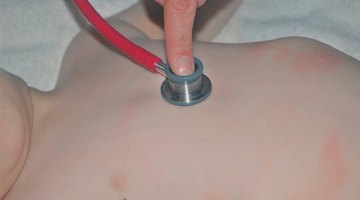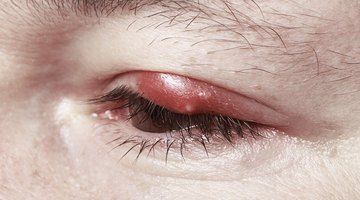What Are the Causes of Rash on a Child's Face & Around the Eyes?
Rashes are very common in children. There are a number of reasons for a rash, and the location can provide a clue to the underlying cause. Other clues may also help your doctor determine the cause, including what the rash looks like and whether it is accompanied by other symptoms such as a fever. Infections and allergies are leading causes of a rash on the face and around the eyes in children.
Infections
A skin infection caused by bacteria -- called cellulitis -- can occur anywhere in the body, including on the face. The rash of cellulitis is usually flat or only slightly raised, bright red and painful when touched. Another common bacterial infection on the face of children is impetigo. This infection shows up as a honey-colored crusty rash around the lips, nose or eyes. Cellulitis and impetigo generally require antibiotics, either applied topically to the skin or taken by mouth as a pill or liquid.
Cellulitis that occurs around the eyes is called periorbital cellulitis. This is a potentially serious condition because it may lead to orbital cellulitis, in which the infection spreads to fat and muscle immediately surrounding the eye. Permanent vision loss can occur with orbital cellulitis. Periorbital and orbital cellulitis often require intravenous antibiotics. If the infection collects in a specific area to form a pus-filled abscess, surgery to drain the abscess may also be necessary.
Allergies

What Causes a Rash Over a Child's Entire Body?
Learn More
Children can have allergic reactions to pollen and other seasonal allergens or they can have a reaction to something in their diet. Infants with a milk allergy may have a rash on the face that starts early in life and goes away only after changing their milk or formula. Older children may develop an allergic reaction to dairy products, shellfish or peanut-containing products. Children with seasonal allergies will have a rash primarily during specific times of the year.
Facial rashes caused by an allergic reaction often consist of red, raised, scaly patches that are dry or ooze a clear fluid. This type of rash is called atopic or allergic dermatitis. Other allergic reactions may cause urticaria, which is a red rash consisting of blister-like bumps called hives. Atopic dermatitis and urticaria are generally very itchy. Scratching should be avoided, as it can introduce bacteria into the rash, resulting in an infection.
Systemic Conditions
A number of systemic conditions affecting diffuse parts of the body can produce a rash on the face and around the eyes. Systemic lupus erythematosus -- also known as SLE or simply lupus -- usually affects preteens and adolescents. This systemic, autoimmune disease can cause:
- a malar
- or butterfly
- rash
- which is a pale red rash under the eyes
- over the bridge of the nose
Certain nutritional deficiencies can also cause a rash on the face. Insufficient zinc, for example, may produce a crusty face rash.
Seeking Medical Attention

Baby Formula & Eczema
Learn More
If the rash lasts more than a couple days, bring your child to the doctor to determine the cause. Seek prompt medical attention if the rash is very close to the eyes or if your child has a high fever, is unusually drowsy or appears to be very ill in any other way.
Reviewed by: Mary D. Daley, MD











